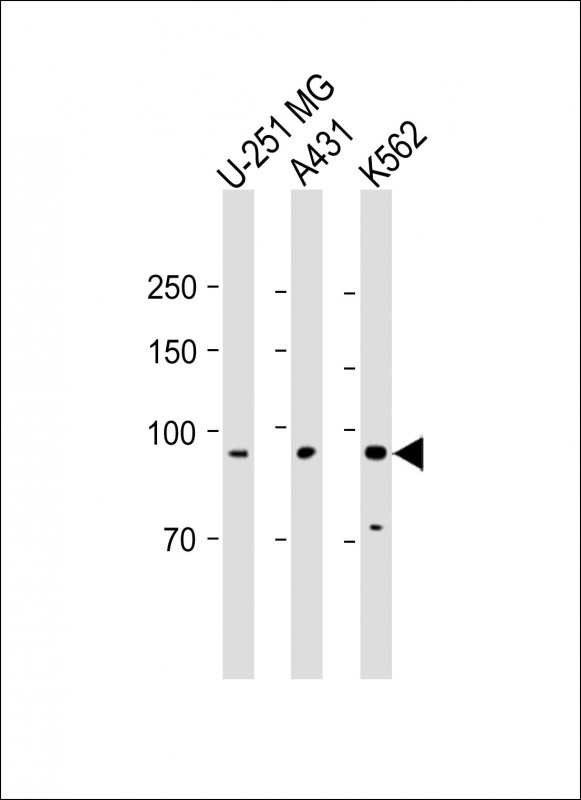PCAF Antibody (C-term)
Purified Rabbit Polyclonal Antibody (Pab)
- 产品详情
- 文献引用 : 1
- 实验流程
- 背景知识
Application
| WB, E |
|---|---|
| Primary Accession | Q92831 |
| Other Accession | Q9JHD1, NP_003875.3 |
| Reactivity | Human |
| Predicted | Mouse |
| Host | Rabbit |
| Clonality | Polyclonal |
| Isotype | Rabbit IgG |
| Calculated MW | 93013 Da |
| Antigen Region | 802-832 aa |
| Gene ID | 8850 |
|---|---|
| Other Names | Histone acetyltransferase KAT2B, Histone acetyltransferase PCAF, Histone acetylase PCAF, Lysine acetyltransferase 2B, P300/CBP-associated factor, P/CAF, KAT2B, PCAF |
| Target/Specificity | This PCAF antibody is generated from rabbits immunized with a KLH conjugated synthetic peptide between 802-832 amino acids from the C-terminal region of human PCAF. |
| Dilution | WB~~1:1000 E~~Use at an assay dependent concentration. |
| Format | Purified polyclonal antibody supplied in PBS with 0.05% (V/V) Proclin 300. This antibody is purified through a protein A column, followed by peptide affinity purification. |
| Storage | Maintain refrigerated at 2-8°C for up to 2 weeks. For long term storage store at -20°C in small aliquots to prevent freeze-thaw cycles. |
| Precautions | PCAF Antibody (C-term) is for research use only and not for use in diagnostic or therapeutic procedures. |
| Name | KAT2B {ECO:0000303|PubMed:27796307, ECO:0000312|HGNC:HGNC:8638} |
|---|---|
| Function | Functions as a histone acetyltransferase (HAT) to promote transcriptional activation (PubMed:8945521). Has significant histone acetyltransferase activity with core histones (H3 and H4), and also with nucleosome core particles (PubMed:8945521). Has a a strong preference for acetylation of H3 at 'Lys-9' (H3K9ac) (PubMed:21131905). Also acetylates non-histone proteins, such as ACLY, MAPRE1/EB1, PLK4, RRP9/U3-55K and TBX5 (PubMed:10675335, PubMed:23001180, PubMed:23932781, PubMed:26867678, PubMed:27796307, PubMed:29174768, PubMed:9707565). Inhibits cell-cycle progression and counteracts the mitogenic activity of the adenoviral oncoprotein E1A (PubMed:8684459). Acts as a circadian transcriptional coactivator which enhances the activity of the circadian transcriptional activators: NPAS2-BMAL1 and CLOCK-BMAL1 heterodimers (PubMed:14645221). Involved in heart and limb development by mediating acetylation of TBX5, acetylation regulating nucleocytoplasmic shuttling of TBX5 (PubMed:29174768). Acts as a negative regulator of centrosome amplification by mediating acetylation of PLK4 (PubMed:27796307). Acetylates RRP9/U3-55K, a core subunit of the U3 snoRNP complex, impairing pre-rRNA processing (PubMed:26867678). Acetylates MAPRE1/EB1, promoting dynamic kinetochore-microtubule interactions in early mitosis (PubMed:23001180). Also acetylates spermidine (PubMed:27389534). |
| Cellular Location | Nucleus. Cytoplasm, cytoskeleton, microtubule organizing center, centrosome. Cytoplasm Note=Mainly localizes to the nucleus. Also localizes to centrosomes in late G1 and around the G1/S transition, coinciding with the onset of centriole formation. Subcellular location may vary depending upon cell differentiation state. Cytoplasmic at the very stages of keratinocyte differentiation, becomes nuclear at later differentiation stages Cytoplasmic in basal epithelial cells (undifferentiated cells) and nuclear in parabasal cells (differentiated cells) (PubMed:20940255) Localizes to sites of DNA damage (PubMed:25593309) |
| Tissue Location | Ubiquitously expressed but most abundant in heart and skeletal muscle. Also expressed in the skin, in keratinocytes (at protein level) (PubMed:20940255). |
For Research Use Only. Not For Use In Diagnostic Procedures.

Provided below are standard protocols that you may find useful for product applications.
BACKGROUND
CBP and p300 are large nuclear proteins that bind to many sequence-specific factors involved in cell growth and/or differentiation, including c-jun and the adenoviral oncoprotein E1A. The protein encoded by this gene associates with p300/CBP. It has in vitro and in vivo binding activity with CBP and p300, and competes with E1A for binding sites in p300/CBP. It has histone acetyl transferase activity with core histones and nucleosome core particles, indicating that this protein plays a direct role in transcriptional regulation.
REFERENCES
Perez, R.E., et al. J. Cell. Physiol. 225(2):394-405(2010)
Mooney, S.M., et al. J. Biol. Chem. 285(40):30443-30452(2010)
Aoyama, T., et al. J. Biol. Chem. 285(39):29842-29850(2010)
Rose, J.E., et al. Mol. Med. 16 (7-8), 247-253 (2010) :
Shimahara, A., et al. J. Biol. Chem. 285(22):16967-16977(2010)
终于等到您。ABCEPTA(百远生物)抗体产品。
点击下方“我要评价 ”按钮提交您的反馈信息,您的反馈和评价是我们最宝贵的财富之一,
我们将在1-3个工作日内处理您的反馈信息。
如有疑问,联系:0512-88856768 tech-china@abcepta.com.






















 癌症的基本特征包括细胞增殖、血管生成、迁移、凋亡逃避机制和细胞永生等。找到癌症发生过程中这些通路的关键标记物和对应的抗体用于检测至关重要。
癌症的基本特征包括细胞增殖、血管生成、迁移、凋亡逃避机制和细胞永生等。找到癌症发生过程中这些通路的关键标记物和对应的抗体用于检测至关重要。 为您推荐一个泛素化位点预测神器——泛素化分析工具,可以为您的蛋白的泛素化位点作出预测和评分。
为您推荐一个泛素化位点预测神器——泛素化分析工具,可以为您的蛋白的泛素化位点作出预测和评分。 细胞自噬受体图形绘图工具为你的蛋白的细胞受体结合位点作出预测和评分,识别结合到自噬通路中的蛋白是非常重要的,便于让我们理解自噬在正常生理、病理过程中的作用,如发育、细胞分化、神经退化性疾病、压力条件下、感染和癌症。
细胞自噬受体图形绘图工具为你的蛋白的细胞受体结合位点作出预测和评分,识别结合到自噬通路中的蛋白是非常重要的,便于让我们理解自噬在正常生理、病理过程中的作用,如发育、细胞分化、神经退化性疾病、压力条件下、感染和癌症。






